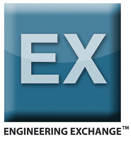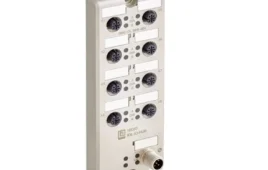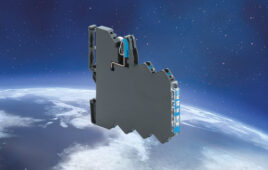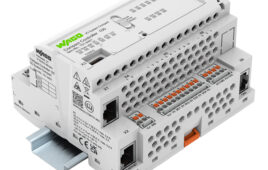By Jeroen Lanslots, Product Manager, Acoustics – Filip Deblauwe, Technical Manager – Karl Janssens, RTD Project Manager – LMS International, Leuven, Belgium
A review of the most common sound source localization techniques helps you select the most appropriate one for today’s industrial applications.

Where does the sound orginate? In general, you have methods that fall into three categories; near-field acoustic holography, beamforming, and inverse methods. Even though these methods have undergone constant improvement, the problem remains that there is not one “magical” single sound source localization technique that prevails over the others. The right technique will depend on the test object, the nature of the sound, and the actual environment.
Therefore, initially examine spatial resolution and dynamic range. Other criteria to examine include frequency range, distance to the source, physical properties of the sound source, and operational conditions.

Figure 1: A sound source localization test on a vehicle’s door panel.
Overview of sound source localization techniques
Near-field Acoustic Holography (NAH) is a technique where the microphone array is placed relatively close to the sound source. The near field can be described as the area that is closer to the sound source than one or two wavelengths of the highest frequency. NAH was introduced in the mid-eighties, and industrialized in the mid ‘90s.
NAH measures sound pressure by arranging several microphones in a rectangular planar array. Microphones are regularly spaced both horizontally and vertically. The sound pressure in the plane is then back-propagated to the actual surface of the object. The spacing between the microphones determines the half-wavelength of the maximum frequency, and the size of the array determines the half-wavelength of the minimum frequency. The spacing also determines the spatial resolution; a coarsely spaced array cannot accurately localize sources on the fine mechanics of a small object.
NAH has several advantages. First, the spatial resolution is independent of frequency and equals the microphone spacing in the hologram. Also, using the Dirachlet Green function allows propagation from the measured pressure field to a velocity field. This method supports sound intensity calculations and, therefore, sound power calculation for different zones or components.
The NAH method is a precise engineering tool for source localization. However, it does have some disadvantages. For instance, it can only propagate sound pressure to a surface that’s parallel to the measured surface. The size of the propagation plane has to be identical to the measured plane. To localize a source on a complete vehicle, the measurement plane has to span the complete vehicle. For stationary applications and repeatable transient applications, such as slow engine run-ups or door slams, the data can be acquired in batches. As a result, it’s possible to perform NAH measurements with a 20 to 30-channel data acquisition system. Also, the higher the required maximum frequency, the closer you should space the microphones. Practically speaking, NAH can be inconvenient for higher frequencies due to the large amount of data required to achieve a good analysis.
One example involves air pump noise on a small 12 cm wide air pump. The hologram size is 27 cm x 27 cm, derived from 3 cm spacing resulting in a maximum frequency of 5700 Hz. Based on critical frequencies found in the spectrum, various holograms show the rotating pump itself, the air outlet, and the air intake. This example shows that it’s possible to propagate to frequencies with a half-wavelength larger than the hologram size. This still allows correct localization at the expense of less reliable quantification results. Besides that, with small structures, it’s important to take the granularity of possible sound sources into account, and match microphone spacing accordingly. In this case, the 3 cm spacing matches the size of the different small pump components.
Beamforming
In beamforming, the microphone array is placed in the far field. As a rule of thumb, the far field is defined as being further away from the source than the array dimensions or diameter. In the near field, sound waves behave like circular or spherical waves, whereas in the far field they become planar waves.
Beamforming arrays support a number of microphone configurations. In general, the configuration is usually a trade-off between dynamic range and source localization accuracy. To get the best of both worlds, it’s best to select a circular array with a pseudo-random microphone distribution.
In the far field, it’s possible to propagate the measured sound field directly to the test object. All microphone signals measured by the beamforming array are added together, taking into account the delay corresponding to the propagation distance. The pressure can be calculated at any point in front of the array, allowing propagation to any kind of surface.
Beamforming requires that all data be measured simultaneously and is typically done with a measurement system of 40 channels or more. The advantages of beamforming are that propagation doesn’t relate to the size of the measurement array so the test object can be larger than the array. With a 0.5 m diameter array, it’s possible to propagate pressure to an entire car. Also, because of the relatively fast acquisition and analysis speed, beamforming lets engineers evaluate several configurations in a limited amount of time.
This flexibility does have some down sides. For instance, the spatial resolution is proportional to the wavelength:

where d is the distance between the source and array, D the array diameter, and λ the wavelength. In an ideal situation, when the antenna is at a distance D to the source, the resolution is equal to the wavelength. If the array is placed farther from the structure, the resolution becomes worse. Beamforming, in general, is only usable at frequencies above 1000 Hz. Beamforming can’t be used to calculate sound power and proper source ranking can’t be done with this technique.
An example involves operational engine noise and the analysis results of an engine run-up in neutral gear inside a semi-anechoic chamber. The goal is to identify tonal components that appear repetitively in the complete time sequence, in this case at 925 Hz and 1250 Hz. The noise sources are identified as the crankshaft pulley and one on the engine core.
Inverse methods
Inverse methods are newer sound source localization methods that solve a system of equations:

where p represents the sound pressure measured at the microphone array, and q represents the localization on the volume velocity or sound distribution on the source.
p and q are related through a transfer function H. Inverse methods solve this system, where q is determined by calculating the inverse of the transfer matrix H and multiplying it by p.
Inverse Boundary Element Model (IBEM) is a method that inverses the wave propagation matrix. IBEM is rarely used because of its high computation time. However, when reducing models to a simplified monopole source distribution, the transfer matrix becomes easy and fast to calculate. This reduction method is called Equivalent Source Method (ESM) or distribution.

Figure 2: The LMS test lab high definition acoustic camera in position for a vehicle sound test.
Some Recent Advances in Sound Source Localization
Near-field focalization
Near-field focalization (NFF) is a beamforming technique based on near-field measurements. It either reprocesses already acquired NAH data or allows the beamforming array to be moved closer to the sound source.
The original beamforming back propagation is reformulated to deal with the spherical near-field waves. NFF improves the spatial resolution to 0.44 λ.
This technique is very useful for wide-angle beamforming acoustic cameras that can zoom into a sound hot spot, providing high-definition source localization. It lowers the threshold of the minimum frequency at which beamforming can be employed.
There is a break-even point at which the spatial resolution of NAH is equal to focalization. Above that frequency, focalization improves spatial resolution. In fact, at the NAH frequency limit, NFF improves spatial resolution by a factor of 2. Obtaining the same accuracy with NAH would mean that the spacing between the array microphones should be increased by a factor 2. This translates to 4 times more microphones and requires a larger number of transducers and measurement channels, which increases hardware investments and maintenance costs.
Spherical beamforming
Another recent development is spherical beamforming. It can be applied in complex, reflective sound fields, such as the interior of a vehicle or the cabin areas in trains and airplanes.
Spherical beamforming uses a far-field beamforming technique in an interior cavity, which is a reflective sound field, and employs a closed spherical array. Therefore, the technique helps identify the exact position of a sound source in the surrounding space. Verifiable experiments point out that, when compared with closed spheres, open spheres suffer from poorer spatial resolution in the lower frequencies and from a lower dynamic range in the mid and high frequency ranges.
Spherical beamforming allows back propagation of the measured sound on the geometry. Back propagating sound to a location that is further away or closer to the spherical array than the actual sound source leads to errors and lower dynamic range. Using the actual geometry of the interior has clear advantages over using a virtual sphere around the acoustic antenna.

Figure 3. The image shows sound sourcing for a car door slam using the near-field acoustic holography (NAH) technique.
Near-field acoustic holography with irregular arrays
NAH requires a rectangular array with evenly spaced microphones, both horizontally and vertically. NAH can’t be performed with a beamforming array as it isn’t rectangular and it has a pseudo-random microphone distribution.
To overcome this, the problem is rewritten as an inverse method. The transfer function in this formulation includes both propagated and evanescent wave functions, and needs an optimal and stable PCA-based regularization, which includes evanescent wave filtering.
Together with beamforming and focalization it offers good spatial resolution and wide frequency range with a single hardware investment.
Inverse numerical acoustics
Inverse numerical acoustics (or INA) reconstructs the surface normal velocities on a vibrating structure from the sound measured in the near field around the structure. This is of particular interest when the structure is rotating or moving, too light or too hot to be instrumented by accelerometers. Laser vibrometers lack the ability to handle the complex shape of the source. The retrieved surface normal velocities can afterwards be used to carry out source ranking for different panels of the structure and to predict the pressure in the far field.
INA is a unique and hybrid solution as it combines experimental sound pressure data in the near field, measured by a microphone array, with Acoustic Transfer Vectors (ATVs) obtained from simulation.
Selecting a sound source localization technique
There is no universal solution for accurate sound source localization. The first thing you would do is to measure the sound of the object under study with a single microphone from a relevant position, usually in the far field. From a single microphone spectrum, a number of critical peaks or frequency ranges can be identified, resulting in a minimum frequency fmin and a maximum frequency fmax.
As a general rule, near field techniques should be preferred, when possible, as they often provide the best results in terms of dynamic range and spatial resolution. The combined near-field acoustic holography and near-field focalization approach (combined NAH-NFF) delivers optimal results, as NAH is the most suitable technique in the low and mid frequency range, and NFF most appropriate for higher frequencies.
Combined NAH-NFF requires that the array’s dimension matches the object size since it back-propagates sounds perpendicularly to the array’s surface. The array dimension in turn determines the number of required microphones and measurement channels. The array width depends on the size of the object and the minimum frequency of interest. For objects that are too big to reasonably match the size of an array, it’s possible to use NAH and NFF to perform measurements in different patches. In that case, the object’s condition has to be stationary. If the condition is not stationary, it should at least be a repeatable transient condition, such as a run-up in function of rpm, or a repeatable impulse noise, such as a door slam.
There are some cases where combined NAH-NFF isn’t practical; where it isn’t possible to measure in the near field, the array size becomes too big, or it isn’t possible to measure in patches due to rapidly changing operational conditions. In these cases, beamforming is the best choice. A good strategy is to first use classical beamforming like a far field wide angle acoustic camera to get a global view on where the sound sources are located. As a next step, the acoustic camera is moved into the near field (at +/- 20 cm) for a zoomed view of these sound sources using focalization. Finally, further refinement in low and mid frequency can be obtained using NAH for irregular arrays with the same data.
Assessing sound source localization techniques
The ultimate goal of any technique is to accurately project the sound origin on an image of the test object. The sound source is represented as a red spot. Two important criteria help assess the result quality:
• Spatial resolution is the ability to separate 2 sound sources. It represents the closest distance between two sources, where they still appear separately and do not merge into a single source. The lower the spatial resolution, the better the source localization.
• Dynamic range expresses sound level differences in dB between real sound sources and the surrounding mathematical artifacts inherent to the sound source localization techniques. The higher the dynamic range, the better the source localization. In beamforming techniques, the dynamic range is also linked to the frequency: the lower the frequency, the higher the dynamic range.
Discuss this on The Engineering Exchange:

LMS International
www.lmsintl.com
Filed Under: Automotive, TEST & MEASUREMENT





Tell Us What You Think!